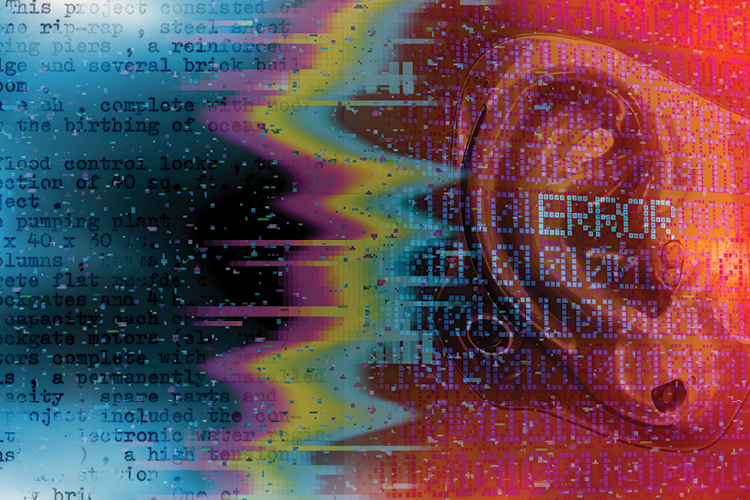Court reporters are fighting back against generative AI

Photo illustration by Sara Wadford/ABA Journal
In last year’s high-profile double murder trial of South Carolina lawyer Alex Murdaugh, there was a moment that underscored just how important human court reporters have always been to trial courts. Defense counsel ordered a rough draft transcript from a digital recording of a prior day’s proceeding. The poor quality of the draft was deemed “not of much use” and discussed the next day in court.
Defense attorneys were able to continue with the trial, which ended with a conviction of Murdaugh. However, there have been cases where convictions were reversed or vacated on appeal based on faulty digital recording and transcription equipment used in place of human court reporters.
Emerging technologies have threatened court reporters since tape recorders became widely available. Yet they have withstood the challenges of advancing technology despite many courts replacing human court reporters with digital recording equipment.
Now, an even more significant challenge presents itself: artificial intelligence. Unlike other professionals, court reporters have balked at it.
“Taking out the human element makes handling all the variable elements in the courtroom difficult. Emotions run high, people are anxious to tell their stories, and they speak fast. If you’re asking an AI to decipher that, the algorithm may change the meaning,” says Kristin Anderson, a court reporter in Denton, Texas, and the president of the National Court Reporters Association. “When I don’t think I heard something correctly, I can have them repeat it.”
Promising tech?
Budget constraints and the public’s expectations of broader access to courts have pushed many courts to replace stenographic court reporters with digital recording systems, which promise to improve the efficiency of transcript production, broaden access to court records and integrate with court management systems.
Digital recording systems with automatic speech recognition use machine learning or AI to process human speech into readable text. Automatic speech recognition technology learns which words are most likely spoken and predicts which words will probably follow from speech. The technology is not foolproof, and its accuracy depends on several factors, including the quality of the audio signals, the complexity of language and the speakers’ accents. You can witness automatic speech recognition at work in many apps, including Instagram and TikTok for real-time captioning; Spotify for podcast transcriptions; and Zoom for event transcriptions.
 Kristin Anderson. (Photo by Thomas Judd Photography)
Kristin Anderson. (Photo by Thomas Judd Photography)But according to Tony Douglass, CEO of For The Record, a provider of audio and visual recording products for courts, consumer-facing automatic speech recognition technology is not representative of digital court recording systems.
Douglass says there are two pillars to accurate court recording: “One is the audio quality, and the other is the automatic speech recognition quality. You can make massive strides in automatic speech recognition quality if you make significant strides in audio quality,” he says.
For The Record does not use the predictive methods available with automatic speech recognition, Douglass says. Its speech-to-text output links recorded audio and video directly to written words, which can help verify the accuracy of a transcript and offer valuable insight into meaning with tone and body language.
“A speech-to-text draft transcript linked to audio and video provides ultimate transparency, assurance of accuracy and valuable insight into tone and body language; this intelligence is not preserved with the traditional stenographic method,” Douglass says. “If a certified transcript is needed, courts can provide the speech-to-text draft transcript to a digital court reporting firm for production.”
High stakes
Any lawyer who reviews an audio recording of a proceeding or has it transcribed knows the peril of solely relying on a digital recording system. The quality of audio recordings can lead to gaps in testimony where audio was not captured, inaudible or garbled. Without a proper authentic record of what occurred in the trial court, an appellate court may decide matters of law based on the “best available means, including the appellant’s recollection.”
In Cleveland v. McGervey, the defendant was convicted in 2020 in Cleveland Municipal Court of aggravated disorderly conduct. On appeal, the court found that the trial court did not engage the audio system until after the prosecution began cross-examination. Since the appellate court could not achieve a “meaningful appellate review,” it ordered a new trial.
Four years prior, a North Carolina appellate court ordered a new trial because recording equipment malfunctioned and prevented the court reporter from producing a full transcript of the trial, including crucial portions of the victim’s testimony.
Many courts now use human reporters to monitor courtroom digital recordings and reduce errors. Other courts look solely to computer automation and automatic speech recognition to clarify digital recording mistakes.
“But when ASR misunderstands a word, it may be omitted or substituted with another word, changing the meaning of what was said,” Anderson says. Also, research has shown that automatic speech recognition accuracy leaves much room for improvement and can demonstrate bias. For example, error rates for Black speakers are nearly double those for white speakers.
The real thing?
Digital audio authentication is an emerging issue for the courts, lawyers and the public. Generally, authenticating an audio recording is accomplished by a party involved in the recorded events or the recording process affirming the events heard during audio playback are consistent with the party’s recollection of the events.
But suppose this is not possible or the opposing party challenges the recollection. In that case, a scientific analysis is required to test, authenticate and verify the audio record has not been edited.
“It is becoming increasingly easy to manipulate digital audio records using generally accessible software,” says Edward Primeau, digital media forensic expert and expert witness for Primeau Forensics, and CEO of Primeau Companies. Edited open source audio records exported from court systems, he adds, can spread misinformation to the public, damage the judicial system’s integrity, influence the courts’ decisions and sway juries if part or parcel of an unauthenticated record enters into evidence in a retrial or appeal. Furthermore, Primeau says, “Authenticating an audio recording is challenging and requires a forensic audio-visual expert, a scientific methodology, lab testing and critical listening to hear a change in background noise that can indicate an edit.”
Compare the certification of a court reporter’s firsthand knowledge as a witness to the proceedings they stenographically record. “Steno reporters are charged with making an accurate record, [they] guarantee the chain of custody of that record, and their methodology is easily verifiable using the embedded stenographic watermark in their file,” Anderson says.
“Stenographic reporters use computer-aided transcription software and real-time skills to capture more than 225 spoken words per minute and provide almost instantaneous translation of the spoken word in the courtroom,” she adds.
For nearly 20 years, a function in computer-aided transcription software instantaneously transfers stenographic strokes or steno into the language of a proceeding in real time.
“Court reporters can review their steno without having to reel back a paper roll—the marks display [in a window] on the machine,” Anderson says. The steno machine time-stamps every steno stroke and can synchronize with audio captured in court proceedings. According to Anderson, court reporters strive to transcribe every word in a proceeding with 99% accuracy.
When Primeau goes under oath as an expert witness and sees someone with a steno machine, he feels “warm and fuzzy, because they are a witness to my testimony, and they’ll stop me if they don’t understand something.”
This story was originally published in the June-July 2024 issue of the ABA Journal under the headline: “Reporter Resistance: As generative AI makes inroads into the legal industry, court reporters are fighting it.”
Write a letter to the editor, share a story tip or update, or report an error.


